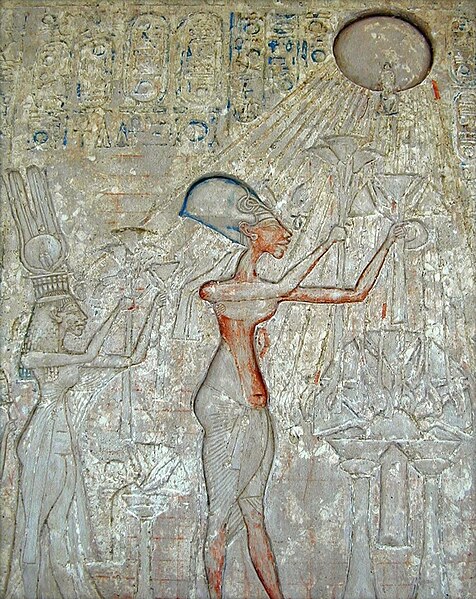Atenism, also known as the Aten religion, the Amarna religion, and the Amarna heresy, was a religion in ancient Egypt. It was founded by Akhenaten, a pharaoh who ruled the New Kingdom under the Eighteenth Dynasty. The religion is described as monotheistic or monolatristic, although some Egyptologists argue that it was actually henotheistic. Atenism was centred on the cult of Aten, a god depicted as the disc of the Sun. Aten was originally an aspect of Ra, Egypt's traditional solar deity, though he was later asserted by Akhenaten as being the superior of all deities. In the 14th century BC, Atenism was Egypt's state religion for around 20 years, and Akhenaten met the worship of other gods with persecution; he closed many traditional temples, instead commissioning the construction of Atenist temples, and also suppressed religious traditionalists. However, subsequent pharaohs toppled the movement in the aftermath of Akhenaten's death, thereby restoring Egyptian civilization's traditional polytheistic religion. Large-scale efforts were then undertaken to remove from Egypt and Egyptian records any presence or mention of Akhenaten, Atenist temples, and assertions of a uniquely supreme god.

Limestone relief at Amarna depicting Akhenaten, Nefertiti, and their children adoring Aten, c. 1372–1355 BC
The name of god Amun was erased, probably during the Amarna era of Akhenaten. Detail of stela of Djeserka, a doorkeeper of the Amun temple at Thebes. From Thebes, Egypt. The Petrie Museum of Egyptian Archaeology, London
Hieroglyphs on the backpillar of Amenhotep III's statue. There are 2 places where Akhenaten's agents erased the name Amun, later restored on a deeper surface. The British Museum, London
Detail of funerary stela of Amenemhat. The name of God Amun was erased by Akhenaten's agents. Limestone, painted. From Egypt, early 18th Dynasty. The Burrell Collection, Glasgow
Ancient Egypt was a civilization of ancient Northeast Africa. It was concentrated along the lower reaches of the Nile River, situated in the place that is now the country Egypt. Ancient Egyptian civilization followed prehistoric Egypt and coalesced around 3100 BC with the political unification of Upper and Lower Egypt under Menes. The history of ancient Egypt unfolded as a series of stable kingdoms interspersed by periods of relative instability known as “Intermediate Periods.” The various kingdoms fall into one of three categories: the Old Kingdom of the Early Bronze Age, the Middle Kingdom of the Middle Bronze Age, or the New Kingdom of the Late Bronze Age.
A typical Naqada II jar decorated with gazelles (Predynastic Period)
Early tomb painting from Nekhen, c. 3500 BC, Naqada, possibly Gerzeh, culture
The Narmer Palette depicts the unification of the Two Lands.
The pyramids of Giza are among the most recognizable symbols of ancient Egyptian civilization.








